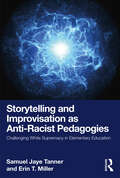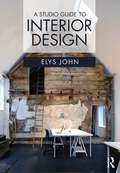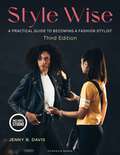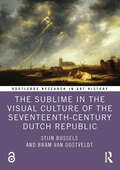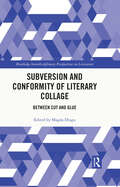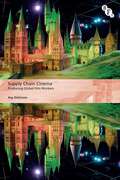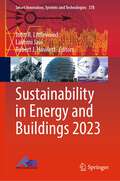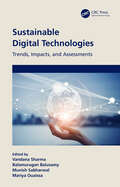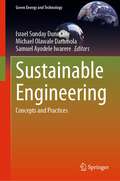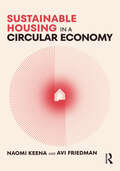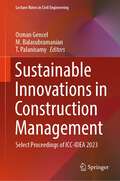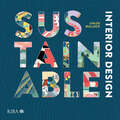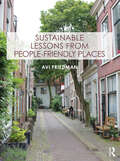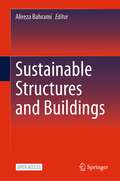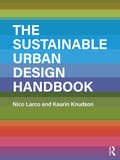- Table View
- List View
Storytelling and Improvisation as Anti-Racist Pedagogies: Challenging White Supremacy in Elementary Education
by Samuel Jaye Tanner Erin T. MillerThis book theorizes and describes the concept of transformative critical whiteness pedagogies that are rooted in theories and practices of improvisation. It shows how these pedagogies invite people, especially white people, into the urgent work of resisting the ongoing production and affirmation of white supremacy.Using the frameworks of storytelling and story analysis, this book uses narrative to invite the reader into ongoing work to design and make sense of teaching and learning about whiteness that would meaningfully account for a grapple with white supremacy. Chapter 1 offers the conceptual framework rooted in theories and practices of improvisation that allow for new ways to think about engaging whiteness in anti-racist pedagogies, which the authors name transformative critical whiteness pedagogies. Chapters 2–4 tell and analyze the stories that emerged out of this work to design and facilitate transformative critical whiteness pedagogies with white elementary students, white college students, and then black elementary students in the US. Chapters 5 and 6 discuss the challenges of developing and implementing transformative critical whiteness pedagogies in K-12 contexts. The final chapters offer a discussion of the improvisational ethos, as well as an overview of the authors’ ongoing work to engage people, especially white people, in getting smarter about whiteness.Using simple, straightforward language to address complex ideas about anti-racist pedagogies, this volume will be important reading for pre-service teachers and teacher educators in Critical Whiteness Studies, Critical Multicultural Education, Social Foundations of Education, Elementary Education, and Race and Culture Studies.
Storytelling and Improvisation as Anti-Racist Pedagogies: Challenging White Supremacy in Elementary Education
by Samuel Jaye Tanner Erin T. MillerThis book theorizes and describes the concept of transformative critical whiteness pedagogies that are rooted in theories and practices of improvisation. It shows how these pedagogies invite people, especially white people, into the urgent work of resisting the ongoing production and affirmation of white supremacy.Using the frameworks of storytelling and story analysis, this book uses narrative to invite the reader into ongoing work to design and make sense of teaching and learning about whiteness that would meaningfully account for a grapple with white supremacy. Chapter 1 offers the conceptual framework rooted in theories and practices of improvisation that allow for new ways to think about engaging whiteness in anti-racist pedagogies, which the authors name transformative critical whiteness pedagogies. Chapters 2–4 tell and analyze the stories that emerged out of this work to design and facilitate transformative critical whiteness pedagogies with white elementary students, white college students, and then black elementary students in the US. Chapters 5 and 6 discuss the challenges of developing and implementing transformative critical whiteness pedagogies in K-12 contexts. The final chapters offer a discussion of the improvisational ethos, as well as an overview of the authors’ ongoing work to engage people, especially white people, in getting smarter about whiteness.Using simple, straightforward language to address complex ideas about anti-racist pedagogies, this volume will be important reading for pre-service teachers and teacher educators in Critical Whiteness Studies, Critical Multicultural Education, Social Foundations of Education, Elementary Education, and Race and Culture Studies.
A Studio Guide to Interior Design
by Elys JohnA Studio Guide to Interior Design leads you through the creative process of developing an interior design proposal. From reading existing buildings, to presenting the final design, each stage is illustrated with analytical diagrams demonstrating clearly the workflow, processes and skills needed at each stage of the design process. Throughout the book there are key references to drawing, digital practice, author illustrated diagrams and design precedents. The book shows how to effectively read existing architecture and interiors and sets out orthographic drawing principles, to be used as an integral part of conceptual design development. It also looks at the integration of technology within the design process. The book has a complementary focus towards hand drawing and digital practice and uses a case study driven, diagrammatic approach so students can readily apply programmatic concepts to their own project context. Ideally suited to students at the beginning of their course, the book covers everything students need to get to grips with early on in their studies and features a wealth of pedagogical features.
A Studio Guide to Interior Design
by Elys JohnA Studio Guide to Interior Design leads you through the creative process of developing an interior design proposal. From reading existing buildings, to presenting the final design, each stage is illustrated with analytical diagrams demonstrating clearly the workflow, processes and skills needed at each stage of the design process. Throughout the book there are key references to drawing, digital practice, author illustrated diagrams and design precedents. The book shows how to effectively read existing architecture and interiors and sets out orthographic drawing principles, to be used as an integral part of conceptual design development. It also looks at the integration of technology within the design process. The book has a complementary focus towards hand drawing and digital practice and uses a case study driven, diagrammatic approach so students can readily apply programmatic concepts to their own project context. Ideally suited to students at the beginning of their course, the book covers everything students need to get to grips with early on in their studies and features a wealth of pedagogical features.
STYLE: Photographs for Vogue
by Norman Parkinson'Norman Parkinson will never go out of style' VOGUEMeet the man who invented style. Through his beautiful photographs for British, American, French and Australian Vogue magazines, Norman Parkinson defined the way we saw fashion in 20th century, from the New Look of 1950s Paris to the Swinging Sixties in London.The breathtaking book collects hundreds of Parkinson's greatest photographs taken for Vogue magazine, gathering pioneering fashion shoots, iconic cover images, royal portraits, celebrity pieces and more.Accompanied by detailed captions and features on key models and collaborators – from Grace Coddington and Jerry Hall to Iman and HRH Princess Anne – STYLE: Photographs for Vogue is a sublime, glamorous tribute to an eternally stylish magazine and the dazzling vision of a man who shaped the face of fashion across six decades.
Style Wise: A Practical Guide to Becoming a Fashion Stylist - with STUDIO
by Jenny B. DavisStyle Wise: A Practical Guide to Becoming a Fashion Stylist, 3rd Edition is an essential text for turning aspiring stylists into professional stylists. The text presents fashion styling as a form of communication that can both support and challenge social norms such as beauty standards and gender roles. Full-color photos and examples from the runway reflect the fast-paced, vibrant fashion industry and cover topics including photo shoots, fashion shows, and special events. Step-by-step instructions guide readers through crucial areas like business basics, establishing a social media presence, and networking, while hands-on projects provide opportunities to develop a portfolio. Timelines, infographics, interviews, and learning activities that focus on the digital side of the fashion industry boost engagement and bring students up-to-date on careers in styling. New to this Edition:-New “The Go-By”, “The Pull List”, and “Talent Credits” features engage students with controversies in contemporary styling, provide biographies of top designers and brands, and give insights on how key individuals have contributed to the styling profession -Emphasis on diversity, equity, and inclusion represents plus-sized and differently-abled models as well as style icons and moments in fashion history from various geographic, ethnic, and gender groups-Coverage of topical issues such as gender-neutral fashion, cultural appropriation, and the effects of the Covid-19 pandemic -New sections on color theory, fabric, and cultural and religious fashionsSTUDIO Features Include: -Study smarter with self-quizzes featuring scored results and personalized study tips -Review concepts with flashcards of terms and definitions -Access samples of documents, forms, and templates for all stages of planning a photo shoot including a call sheet form, supply checklist, planning calendars, and more Instructor Resources-An Instructor's Guide to help incorporate this text into the classroom, including a test bank to provide options for student assessment -PowerPoint® presentations include images from the book and provide a framework for lecture and discussion
The Sublime in the Visual Culture of the Seventeenth-Century Dutch Republic (Routledge Research in Art History)
by Stijn Bussels Bram Van OostveldtContrary to what Kant believed about the Dutch (and their visual culture) as “being of an orderly and diligent position” and thus having no feeling for the sublime, this book argues that the sublime played an important role in seventeenth-century Dutch visual culture. By looking at different visualizations of exceptional heights, divine presence, political grandeur, extreme violence, and extraordinary artifacts, the authors demonstrate how viewers were confronted with the sublime, which evoked in them a combination of contrasting feelings of awe and fear, attraction and repulsion. In studying seventeenth-century Dutch visual culture through the lens of notions of the sublime, we can move beyond the traditional and still widespread views on Dutch art as the ultimate representation of everyday life and the expression of a prosperous society in terms of calmness, neatness, and order. The book will be of interest to scholars working in art history, visual culture, architectural history, and cultural history.
The Sublime in the Visual Culture of the Seventeenth-Century Dutch Republic (Routledge Research in Art History)
by Stijn Bussels Bram Van OostveldtContrary to what Kant believed about the Dutch (and their visual culture) as “being of an orderly and diligent position” and thus having no feeling for the sublime, this book argues that the sublime played an important role in seventeenth-century Dutch visual culture. By looking at different visualizations of exceptional heights, divine presence, political grandeur, extreme violence, and extraordinary artifacts, the authors demonstrate how viewers were confronted with the sublime, which evoked in them a combination of contrasting feelings of awe and fear, attraction and repulsion. In studying seventeenth-century Dutch visual culture through the lens of notions of the sublime, we can move beyond the traditional and still widespread views on Dutch art as the ultimate representation of everyday life and the expression of a prosperous society in terms of calmness, neatness, and order. The book will be of interest to scholars working in art history, visual culture, architectural history, and cultural history.
Subversion and Conformity of Literary Collage: Between Cut and Glue (Routledge Interdisciplinary Perspectives on Literature)
by Magda DraguSubversion and Conformity of Literary Collage: Between Cut and Glue fills a gap in the current scholarship on literary collage, by addressing how different the interpretations of the concept are, depending on the author who uses the concept and the material and writers surveyed. The book studies writers who employed literary collage during the twentieth and twenty-first centuries, some whose works have been intensely analyzed from this perspective (William S. Burroughs and Walter Benjamin), but also some whose collage-writing style has recently been investigated by writers, being usually placed under the umbrella term of artist books (Stelio Maria Martini).
Subversion and Conformity of Literary Collage: Between Cut and Glue (Routledge Interdisciplinary Perspectives on Literature)
Subversion and Conformity of Literary Collage: Between Cut and Glue fills a gap in the current scholarship on literary collage, by addressing how different the interpretations of the concept are, depending on the author who uses the concept and the material and writers surveyed. The book studies writers who employed literary collage during the twentieth and twenty-first centuries, some whose works have been intensely analyzed from this perspective (William S. Burroughs and Walter Benjamin), but also some whose collage-writing style has recently been investigated by writers, being usually placed under the umbrella term of artist books (Stelio Maria Martini).
Supply Chain Cinema: Producing Global Film Workers (International Screen Industries)
by Kay DickinsonWhy are big budget films typically made across an array of seemingly dissociated sites? Supply Chain Cinema shows how the production journeys of such films exemplify the principles of the supply chain, whose core imperative is to nimbly and opportunistically manufacturing wherever is most amenable and efficient.Through extensive on-site investigations and in-depth interviews with film professionals, Kay Dickinson delivers nuanced insight into working practices in the UK and the UAE. Among the sites she examines is Warner Bros' permanent base at Leavesden Studios near London. From tax breaks designed to attract foreign projects to infrastructures, logistical support and expertise offered, she considers why Hollywood giants elect to make more of their films in Britain than in the USA. Dickinson goes on to show how the UK's ambitions to enlarge its creative economies has opened up a host of competitive advantages with British higher education increasingly fashioned to conform to the needs of border-hopping enterprise, thus generating a workforce keenly adapted to the demands of blockbuster moviemaking.
Sustainability in Energy and Buildings 2023 (Smart Innovation, Systems and Technologies #378)
by John R. Littlewood Lakhmi Jain Robert J. HowlettThis book contains the proceedings of the 15th KES International Conference on Sustainability and Energy in Buildings 2023 (SEB2023) held in Bari, Italy, during September 18–20, 2023, organized by KES International. SEB23 invited contributions on a range of topics related to sustainable buildings and explored innovative themes regarding sustainable energy systems. The conference formed an exciting chance to present, interact, and learn about the latest research and practical developments on the subject. The conference attracted submissions from around the world. Submissions for the full-paper track were subjected to a blind peer-reviewed process. Only the best of these were selected for presentation at the conference and publication in these proceedings. It is intended that this book provides a useful and informative snapshot of recent research developments in the important and vibrant area of sustainability in energy and buildings.
Sustainable Digital Technologies: Trends, Impacts, and Assessments
This book is a reference on digital technology and its impact on sustainability, providing insight into sustainable practices globally. It focuses on the critical practices leading to sustainable initiatives among various organizations, IT infrastructure, communities, and government compliance. The book describes the green computing paradigms and the impact of a circular economy with a focus on sustainable practices in a post-pandemic world. Sustainable Digital Technologies: Trends, Impacts, and Assessments discusses the critical factors leading to sustainable initiatives in a global economy. It highlights the impact of digital technology and Industry 4.0 in today’s world. The book focuses on the role, responsibility, and the effect of the Internet of Things for digital sustainability and practices. It describes implementation strategies for green cloud computing and presents additional strategies for sustainable practices in a post-pandemic world. This publication is designed for use by technology development academicians, data scientists, industrial professionals, researchers, and students interested in uncovering the latest innovations in the field and the current research on problem-oriented processing techniques in sustainable and evolutionary computing applications with reduced energy channelization.
Sustainable Digital Technologies: Trends, Impacts, and Assessments
by Vandana Sharma, Balamurugan Balusamy, Munish Sabharwal, and Mariya OuaissaThis book is a reference on digital technology and its impact on sustainability, providing insight into sustainable practices globally. It focuses on the critical practices leading to sustainable initiatives among various organizations, IT infrastructure, communities, and government compliance. The book describes the green computing paradigms and the impact of a circular economy with a focus on sustainable practices in a post-pandemic world. Sustainable Digital Technologies: Trends, Impacts, and Assessments discusses the critical factors leading to sustainable initiatives in a global economy. It highlights the impact of digital technology and Industry 4.0 in today’s world. The book focuses on the role, responsibility, and the effect of the Internet of Things for digital sustainability and practices. It describes implementation strategies for green cloud computing and presents additional strategies for sustainable practices in a post-pandemic world. This publication is designed for use by technology development academicians, data scientists, industrial professionals, researchers, and students interested in uncovering the latest innovations in the field and the current research on problem-oriented processing techniques in sustainable and evolutionary computing applications with reduced energy channelization.
Sustainable Engineering: Concepts and Practices (Green Energy and Technology)
by Israel Sunday Dunmade Michael Olawale Daramola Samuel Ayodele IwarereSustainable Engineering: Concepts and Practices provides insights into current perspectives on sustainable engineering research. It highlights the drivers, motivations, and challenges affecting the development and adoption of sustainable engineering in various sectors of the economy and how they impact sustainable development. Contributions from researchers representing multiple branches of engineering in academia, government laboratories, and industry present alternative approaches to traditional engineering practices. These approaches effect change, making the design, construction, production, and management of products, processes, and systems more environmentally friendly, socially beneficial, and economically profitable. The book will be a trusted reference for graduate students, practicing engineers, and other professionals interested in developing or using sustainable products and systems.
Sustainable Housing in a Circular Economy
by Naomi Keena Avi FriedmanThis book relates circular economy principles to housing design and construction and highlights how those principles can result in both monetary savings, positive environmental impact, and socio-ecological change.Chapters focus on three key circular economy principles and apply them to architectural construction and design, namely rethinking of the end-of-use phase of a building and the potential of design-for-disassembly; the role of digitization and data standardization in fostering evidence-based circular economy design decision-making; and presenting space as a resource to conserve, via exploration of the sharing economy and flexibility principles. Beyond waste management and material cycles, this book provides a holistic understanding of the opportunities across the building life cycle that can allow for sustainable and affordable circular housing. With case studies from 13 different countries, including but not limited to the Hammarby Sjöstad district in Sweden, the Circle House in Denmark, Benny Farm in Canada, VMD Prefabricated House in Mexico, and the Deep Performance Dwelling in China, authors pair theoretical frameworks with real-world examples.This will be a useful resource for upper-level students and academics of architecture, construction, and planning, especially those studying and researching housing design, building technology, green project management, and environmental design.
Sustainable Housing in a Circular Economy
by Naomi Keena Avi FriedmanThis book relates circular economy principles to housing design and construction and highlights how those principles can result in both monetary savings, positive environmental impact, and socio-ecological change.Chapters focus on three key circular economy principles and apply them to architectural construction and design, namely rethinking of the end-of-use phase of a building and the potential of design-for-disassembly; the role of digitization and data standardization in fostering evidence-based circular economy design decision-making; and presenting space as a resource to conserve, via exploration of the sharing economy and flexibility principles. Beyond waste management and material cycles, this book provides a holistic understanding of the opportunities across the building life cycle that can allow for sustainable and affordable circular housing. With case studies from 13 different countries, including but not limited to the Hammarby Sjöstad district in Sweden, the Circle House in Denmark, Benny Farm in Canada, VMD Prefabricated House in Mexico, and the Deep Performance Dwelling in China, authors pair theoretical frameworks with real-world examples.This will be a useful resource for upper-level students and academics of architecture, construction, and planning, especially those studying and researching housing design, building technology, green project management, and environmental design.
Sustainable Innovations in Construction Management: Select Proceedings of ICC-IDEA 2023 (Lecture Notes in Civil Engineering #388)
by Osman Gencel M. Balasubramanian T. PalanisamyThis book presents the select proceedings of International Conference on Civil Engineering: Innovative Development in Engineering Advances (ICC IDEA 2023). This book covers the latest research in the areas of construction engineering and management, urban planning and design, building energy conservation and green architecture, materials science and engineering, innovation in construction materials, and information technology in civil engineering. The book is useful for researchers and professionals in civil engineering.
Sustainable Interior Design
by Chloe BullockWhat does it mean to be a sustainable interior designer? Where do you start? This book demystifies how to be a sustainable interior designer, both within practice and on design projects. It gives you the tools to educate clients that sustainable practice isn’t necessarily more expensive, and what the options available to them are in terms of design concept, materials and finishes. Importantly, the book also looks at sustainable supply chains, particularly important when specifying FF+E. Where to start being sustainable can be a difficult decision. Acting as a primer for interior designers at any stage of their career, it outlines what you really need – and don’t need – to know. Inspirational case studies from around the world sit alongside crucial guidance on the benefits of being sustainable and how to work with enlightened clients. There is information on how sustainable design contributes to health and wellbeing, all backed up by authoritative best practice guidance.
Sustainable Interior Design
by Chloe BullockWhat does it mean to be a sustainable interior designer? Where do you start? This book demystifies how to be a sustainable interior designer, both within practice and on design projects. It gives you the tools to educate clients that sustainable practice isn’t necessarily more expensive, and what the options available to them are in terms of design concept, materials and finishes. Importantly, the book also looks at sustainable supply chains, particularly important when specifying FF+E. Where to start being sustainable can be a difficult decision. Acting as a primer for interior designers at any stage of their career, it outlines what you really need – and don’t need – to know. Inspirational case studies from around the world sit alongside crucial guidance on the benefits of being sustainable and how to work with enlightened clients. There is information on how sustainable design contributes to health and wellbeing, all backed up by authoritative best practice guidance.
Sustainable Lessons from People-Friendly Places
by Avi FriedmanCurrent planning and design modes of cities are facing challenges of philosophy and form. Past approaches no longer sustain new demands and call for innovative thinking. In a world that is becoming highly urbanized, the need for a new outlook is propelled by fundamental global changes that touch upon environmental, economic and social aspects.The book introduces fundamental principles of timely sustainable urban design, paying attention to architecture, integration of natural features, public urban spaces and their successful use. Readers will learn how cities are transitioning to active mobility by placing the wellbeing of citizens at the heart of planning; making buildings fit nature; supporting local culture through preservation; and including community gardens in neighborhoods, among others. Written by a practicing architect, professor and author, the book is richly illustrated and features meticulously selected international case studies.
Sustainable Lessons from People-Friendly Places
by Avi FriedmanCurrent planning and design modes of cities are facing challenges of philosophy and form. Past approaches no longer sustain new demands and call for innovative thinking. In a world that is becoming highly urbanized, the need for a new outlook is propelled by fundamental global changes that touch upon environmental, economic and social aspects.The book introduces fundamental principles of timely sustainable urban design, paying attention to architecture, integration of natural features, public urban spaces and their successful use. Readers will learn how cities are transitioning to active mobility by placing the wellbeing of citizens at the heart of planning; making buildings fit nature; supporting local culture through preservation; and including community gardens in neighborhoods, among others. Written by a practicing architect, professor and author, the book is richly illustrated and features meticulously selected international case studies.
Sustainable Structures and Buildings
by Alireza BahramiThis open access book includes detail on various structures, buildings, and building materials from different structural and sustainability perspectives. It describes how the building industry is vital for the achievement of the sustainable development goals, namely, economic growth, social progress, and the effective protection of the environment. The aim of this collection is to foster the design and construction of sustainable structures and buildings to reduce the environmental load, connect with the environment, and benefit the health of occupants. Presenting the knowledge, trends, and developments from a group of contributors in the field working with different kinds of structures, structural components, buildings, and building materials, the book is ideal for practitioners working in commercial settings, as well as engineering students and researchers concerned with sustainability issues.
The Sustainable Urban Design Handbook
by Nico Larco Kaarin KnudsonThe Sustainable Urban Design Handbook gathers the best sustainability practices and latest research from the fields of architecture, landscape architecture, planning, development, ecology, and environmental engineering and presents them in a graphically rich and accessible format that can help guide urban design decisions in cities of all sizes.The book presents a comprehensive framework that organizes more than 50 elements of sustainable urban design under five main topics–Energy Use & Greenhouse Gas, Water, Ecology & Habitat, Energy Use & Production, and Equity & Health–and relative to four project scales: Region & City, District & Neighborhood, Block & Street, and Project & Parcel. Each element chapter includes a summary of importance and background, compares typical practices and recommended approaches, explains connections to other elements, and concludes with urban design guidelines that can be used to directly inform projects and decisions.Easy to use and reference, The Sustainable Urban Design Handbook provides both an in-depth introduction to topics across sustainable urban design and serves as an on-going reference for anyone involved in the creation of sustainable urban environments. This resource will be useful to design and planning professionals, community members, students, and elected officials in guiding decisions about our sustainable future.
The Sustainable Urban Design Handbook
by Nico Larco Kaarin KnudsonThe Sustainable Urban Design Handbook gathers the best sustainability practices and latest research from the fields of architecture, landscape architecture, planning, development, ecology, and environmental engineering and presents them in a graphically rich and accessible format that can help guide urban design decisions in cities of all sizes.The book presents a comprehensive framework that organizes more than 50 elements of sustainable urban design under five main topics–Energy Use & Greenhouse Gas, Water, Ecology & Habitat, Energy Use & Production, and Equity & Health–and relative to four project scales: Region & City, District & Neighborhood, Block & Street, and Project & Parcel. Each element chapter includes a summary of importance and background, compares typical practices and recommended approaches, explains connections to other elements, and concludes with urban design guidelines that can be used to directly inform projects and decisions.Easy to use and reference, The Sustainable Urban Design Handbook provides both an in-depth introduction to topics across sustainable urban design and serves as an on-going reference for anyone involved in the creation of sustainable urban environments. This resource will be useful to design and planning professionals, community members, students, and elected officials in guiding decisions about our sustainable future.
